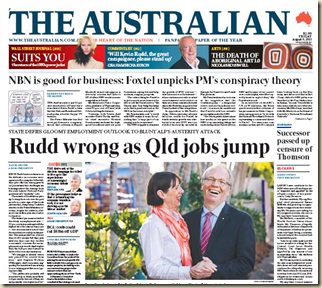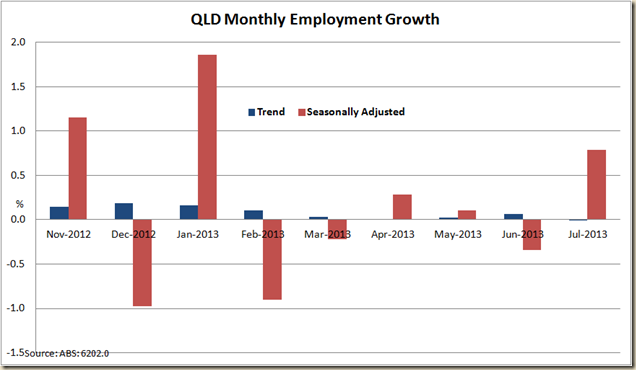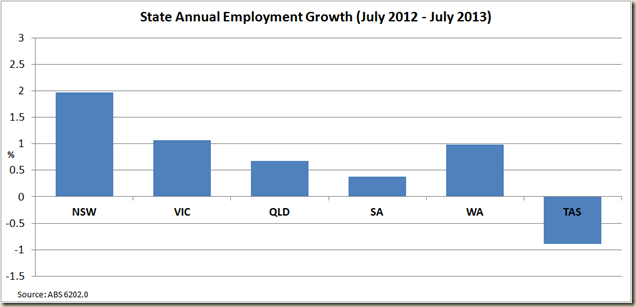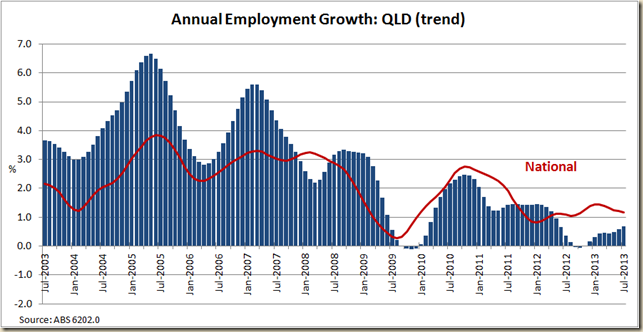This week there has been a lot of focus on the bias exhibited by the front pages of The Daily Telegraph, the Herald Sun and The Courier Mail. It’s clear to anyone for whom reading comprehension isn’t a skill they have yet to acquire that there isn’t much care about balanced reporting. That’s fine, balance is often bullshit in media. It leads to journalists going on Twitter and tweeting that they’re being attack by people on the left and the right. They like doing this because it means other journalists can tweet to them saying it obviously means they’re doing a good job.
Accuracy is better than balance.
So yeah the news.corp tabloids are exhibiting bias, and thus during this campaign it make then worthless in terms of trust. That doesn’t mean they lie, it just means you should get a second opinion on anything written in them – you know things like the shape of the economy, the state of the climate, the health system, whether the sky is blue...
But let’s not let The Oz off the hook.
It can be as bad as its tabloid cousins; it just has a faux veneer of respectability.
Take today’s front page:
Now when you start accusing the Prime Minister of being “wrong” on QLD jobs, you bloody well better be right.
And you damn well better not just cherry pick some data that tells the story you want to tell because to do so really would leave you wide open to charges that you are either incompetent and thus not deserving of the loudness of voice you have, or you are not practising journalism, but spin.
So let’s look at what the journalists, Adam Creighton (he of the “democracy is probably not sustainable”, and the Government's anti-tobacco plan is reminiscent of the Nazis) and David Crowe have to say:
“KEVIN Rudd has been thrown on the defensive on economic management after a surprise fall in full-time jobs offset by strong growth in Queensland that challenges his warnings about the damage from the state Liberal National Party government's "austerity" cuts.
Now when I read this I was a little bit surprised, because when I was looking at QLD’s employment data that came out yesterday (as I do each month, nerd that I am) I saw the employment in QLD fell by 0.0023%.
So I kept reading, and after some paragraphs about the national numbers, they finally got back to QLD (you know, the aspect that warranted the headline):
In a challenge to one of Labor's key election strategies in Queensland, the latest figures showed the state gained 18,500 jobs and saw its unemployment rate fall from 6.3 per cent to 5.9 per cent.
Labor has attacked Queensland Premier Campbell Newman and his LNP government by claiming his cuts to 14,000 public service positions last year would damage the state economy.
And then it because clear. The Australian was quoting the seasonally adjusted figures and not the trend data. Why would they do this, and why is it so stupid? Well first, according to the seasonally adjusted rate, QLD’s unemployment fell from 6.3% to 5.9%. If you use the trend rate, QLD’s unemployment actually rose from 6.0% to 6.1%.
Gee I can’t think why they chose the seasonally adjusted rate.
So clearly the “best” figure has been picked. But why is this stupid?
Well using the seasonally adjusted rate at the state level is incredibly “noisy”. It jumps around a lot. How much? Well look at the past 12 months:
If you believe that the most accurate way to report QLD’s unemployment rate is to say it fell from 6.3% to 5.9%, then you also have to think that the most accurate way to describe the June figures is to say in rose from 5.8% in May to 6.3% in June.
Up 0.5% then down 0.4%? Does that really make sense to you? Of course not. Economies don’t work that way.
And do you think the article at any point either quoted the trend rate or acknowledged that the figure they were using was the seasonally adjusted rate?
Well that would be a no.
Don’t you love journalism that gives you the full picture?
I used to like using seasonally adjusted figures as well as trend for state employment, because they were always good for a laugh, but after a while I stopped bothering.
In May I wrote after seeing that the seasonally adjusted figures had Tasmania as the state with the fastest growing employment in the month:
Yes, Tasmania the big winner, which tells you all you need to know about the worth of seasonally adjusted monthly growth data on a state by state basis. This will be the last time I bother with it. It is next to useless.
Even yesterday when I had a quick look at them I tweeted:
The state seasonally adjusted unemployment numbers are always such fun
In seasonally adjured terms, Tasmania's unemployment rate went from 9.0% to 8.2%!! O_o (the trend rate went from 8.2% to 8.4%)
Yes, in seasonally adjusted terms, Tasmania’s unemployment rate fell from 9.0% to 8.2%. Do you believe that? If so, I’ve got a national newspaper I’d like to sell you.
But you don’t need to trust me. Trust the Australian Bureau of Statistics. They have a very handy page (and seriously EVERY journalist should read it) that is titled:
Interpreting Time Series: Are you being misled by the Seasons, 2012:
WHICH SERIES SHOULD I USE?
On seasonally adjusted data it says this:
SEASONALLY ADJUSTED ESTIMATES
Seasonally adjusted estimates are produced by removing seasonal patterns from the original estimates. They are good for performance measures and comparisons - was that advertising campaign effective, how much tourist traffic did we lose because of the Tsunami, is unemployment doing better in QLD than in TAS. Again, they’re very history focused. Different months are comparable but month-to-month movements are usually dominated by irregular effects. [my highlighting]
and this under “KEY POINT”
HOW ABOUT COMPARING SEASONALLY ADJUSTED DATA FROM ONE PERIOD TO THE NEXT?
Seasonal patterns have been removed from the seasonally adjusted data, however the residual noise and irregular influences are still present. If the residual noise is high it may distort a comparison of seasonally adjusted estimates. Similarly, an unusual event or irregular influence may affect a comparison. For example, consider a series which has an underlying increasing trend. An unusual event such as a strike may lead to a "once-off" low value for one period. [my highlighting]
But we don’t need the ABS to tell us that. Again if we look at the above graph, you KNOW that seasonally adjusted data is bouncing around like a cocaine addict. You don’t need to even have studied statistics. It is obvious.
And to further reinforce it, let’s look at employment growth, and compare seasonally adjusted to trend:
As you can see: in November 2012 a big jump, then a big fall in December, then a big jump, then a fall etc etc. (the reason why you can’t see a blue column in July 2013 is because it is effectively zero precent).
And why do we know the tend figure is the one to focus one? Why because it was the one the Queensland Treasurer himself in June said was the one to look at:
Trend unemployment remains steady
Treasurer Tim Nicholls says today’s ABS Labour Force data shows the trend unemployment rate remains steady in Queensland at 5.7 per cent.
“This comes after seven consecutive months of trend employment growth,” Mr Nicholls said.
“While the more volatile seasonally adjusted rate increased only marginally by 0.1 per cent to 5.8 per cent, the more reliable trend figure shows employment in Queensland is stable and continues to trend in the right direction.
And the journalists knew this was the case because they even got a quote from an economist:
"It appears the state has absorbed the public sector job cuts for now and the unemployment rate is stabilising around 6 per cent,"
The only thing showing any stability – was the trend rate – their entire story is not about stability it is about a “job’s jump”!
So let’s use the the trend rate to compare growth of employment across the nation in July:
Hmmm. So much for that “strong growth in Queensland that challenges [Rudd’s] warnings about the damage from the state Liberal National Party government's "austerity" cuts”.
But look, even monthly growth at the state level in trend terms can be misleading so let’s look at annual growth growth in trend terms across the nation:
Yeah QLD. The place to be. Unless you’re in NSW, Victoria or WA. (Incidentally the continued decline in WA’s employment growth is THE story of yesterday’s data).
Now lets take a long look at QLD employment growth compared to the National growth rate to get an even better perspective of where they’re at:
And remember Campbell Newman came into office in March 2012. Oh what the hell, let’s go in for a close up:
So yes, the growth is getting better, but heck. You think it could have gotten any worse?
So is Rudd wrong?
Nope. The only way you could say jobs “jumped” in QLD in July is if you use data in the way that the people who actually compile the data tell you not to use it.
As I say, trust nothing you read (including my blog, I am not perfect, and certainly not unbiased), get a second opinion. Verify. But realise that one news organisation has bet all their bickies on a Tony Abbott win. That doesn’t mean we should assume everything they write is a lie – they don’t “lie” and I would never suggest they do. But as we have seen today, they can cherry pick data as good as any politicians can. I suggest you treat their statements with the same level of scepticism.
And seek out the full picture.







5 comments:
Another fun blog would be on the use of absolute numbers ($3 billion - the sky is falling!) when a relative indicator (0.05% of GDP - ho hum...) would be more honest
I enjoy your writing, Greg, so wanted to put my side of the story about last Friday’s news report.
My reply goes over your comment limit so I'll post it in two or three parts.
On reading your blog my first instinct was to check with more economists about the seasonally-adjusted versus trend data on Queensland. As you’d expect, I found the economists disagreed. The Commonwealth Bank economists had used seasonally-adjusted figures on Thursday to note that Queensland was doing OK. On Friday I spoke to Stephen Walters from JP Morgan and Scott Haslem from UBS and both put more weight on the seasonally-adjusted figures than the trend.
Stephen Walters put it this way: “This is uniform across the markets – we all look at seasonally-adjusted, no question, on all the data.”
Scott Haslem told me that if you want to identify recent changes, you use seasonally-adjusted data and it was “problematic” to use trend data. (He and Walters say this even though they know the ABS prefers trend data, as you point out). A few other economists didn’t get back to me.
Two others backed your view. Paul Bloxham from HSBC Australia said the trend measures were a more reliable guide. John Daley from the Grattan Institute said the same: “I think the real moral of the story is that it is very easy to read far too much into month-to-month trends, given both the inherent margin for error and the random volatility in the data.”
I put this into a news story on Saturday here: http://www.theaustralian.com.au/national-affairs/election-2013/abbott-buoyed-by-state-job-numbers/story-fn9qr68y-1226694532958
David Crowe
Anyway, the point of my response isn’t really to get into a debate on data methodology.
I think the bigger point is about what’s happening in Queensland versus what Labor said would happen in Queensland.
Obviously Kevin Rudd wants to paint Campbell Newman as a jobs destroyer whose “austerity” policies will cut growth. The rhetoric is pretty strong on this but the data doesn’t back up the attack.
Here’s the PM at the National Press Club in July:
“Mr Abbott’s economic policy for the future is even worse. His prescription is to implement a slash and burn austerity drive across the nation. Well we have seen how that works in Queensland under Campbell Newman where business and consumer confidence has been shaken by the sacking of thousands of people, and the shrinking of critical government services.”
The general claim, across the government, is that Newman’s “austerity” will damage the state economy. Here’s Mark Dreyfus from June:
“Ultimately, austerity measures such as those imposed by the Newman Government are self-defeating. Slashing government services and jobs inflicts pain on those who are sacked, has serious negative impacts on the wider economy, retards growth, undermines the quality of life of those dependent on those services, and threatens to reduce, rather than to increase, government revenue in the future.”
And Craig Emerson (admittedly, no longer a minister but arguing what is essentially the government case) on radio in June:
“What is clear in Queensland is that Campbell Newman and the extreme austerity that he has applied through his budget processes there has flattened the Queensland economy.”
I like Craig Emerson and think he’s a real loss to parliament but is the Queensland policy really “flattening” the state economy?
Based on the data from last Thursday, the Labor claims about imminent damage to the Queensland economy don’t stack up. This is a bigger point than the difference between the seasonally-adjusted and trend data.
While Paul Bloxham from HSBC agreed that it was better to use trend data, he didn’t see anything in the data to support the Labor claims of “retarding” growth. In his view the jobs results in Queensland were broadly steady.
Why let Kevin Rudd get away with predicting mayhem for Queensland when the jobs results don’t bear that out? I wrote in the first paragraph of the initial story that Rudd was “thrown on the defensive” and I think that’s a fair way to describe what the jobs figures meant for his election campaign. But I also put it in the perspective, in the second paragraph, of the one million jobs created since Labor took power in 2007.
Now for the part that is only interesting to journalists and bloggers.
I don’t write the headlines and woke up on Friday to read a tweet, and later a front page, saying: “Kevin Rudd wrong as Queensland jobs jump”.
Was Kevin Rudd “wrong”? Well he certainly wasn’t right. I suppose I might have written a headline saying “Kevin Rudd’s claims challenged by Queensland jobs data.” But I’m hopeless at writing headlines.
I didn’t use the word “jump” in the story but did refer to strong growth in the first paragraph, and I suppose you would dispute that description just as much. I think it was fair enough to contrast the positive result in Queensland compared to the gloomier picture nationally and in the budget forecasts.
I certainly didn’t start the story with a determination to use the seasonally-adjusted figures and ignore the trend data, which is what your blog suggests. The economists pointed out the “buoyant” Queensland figures in their research notes. It made sense to follow that through.
David Crowe
Adam Creighton might also pick up a quotations book before declaring that "democracy is unsustainable." He might find the original Churchill: "Democracy is the worst form of government except for all those others that have been tried."
This is great paradoxical thinking that is beyond the proselytising (and too-busy-to-check-facts Creighton.)
Baden Eunson
Better mug shot- and URL
Post a Comment